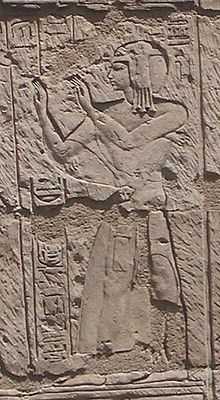Shoshenq D
| Shoshenq High Priest of Ptah in Memphis | |
|---|---|
 Relief representing the High Priest of Ptah Shoshenq. | |
| Predecessor | Osorkon A |
| Successor | Merenptah (High Priest of Ptah) |
| Dynasty | 22nd Dynasty |
| Pharaoh | Osorkon II |
| Father | Osorkon II |
| Mother | Karomama |
| Children | Takelot B, Chief of the Ma. |
| Burial | Saqqara |
| |||||||||||||||
| The Prince, The Greatest of the Directors of the Craftsmen, Shoshenq rp wr ḫ.rpw hmwt ŠŠ-nk in hieroglyphs |
|---|
Shoshenq was a High Priest of Ptah during the 22nd dynasty. Shoshenq was the eldest son of Osorkon II and Queen Karomama. He presided over the burial of the twenty-seventh Apis bull in Saqqara. For unknown reasons Shoshenq did not succeed to his father's throne and was buried in Memphis when Shoshenq III was king of Egypt.[1] Shoshenq's tomb was found unplundered in 1942.[2]
Sheshonq is known to have had a son named Takelot B. Through Takelot B he was the grandfather of a man named Pediese, who was a chief of the Ma, and the great-grandfather of a later High Priest of Ptah named Peftjauawybast.[3]
Items belonging to Shoshenq include:
- Two naophorous kneeling statues (one now in Budapest, Museum of Fine Arts (51.2050), the other in Vienna, Kunsthistorisches Museum (ÄS 5773) - the latter statue, however, bears no securely identifying inscriptions[4]). The Budapest statue gives the titles and family relations of Shoshenq: “Great Chief Prince of His Majesty, High Priest and Sem Priest of Ptah, Great King’s Son of the Lord of the Two lands Usimare Stepenamun, Son of Re, Lord of Epiphanies Osorkon (II) Meryamun Si-Bast, his mother being Karomama”[3]
- A chalice now in Berlin.
- A scarab in the Petrie Museum in London.[2]
| Wikimedia Commons has media related to Shoshenq, High Priest of Ptah. |
References
- ↑ Karl Jansen-Winkeln, "Der Prinz und Hohepriester Schoschenk (D), in: Göttinger Miszellen 207 (2005), pp. 75-80.
- ↑ 2.0 2.1 Dodson and Hilton, The Complete Royal Families of Ancient Egypt, 2004
- ↑ 3.0 3.1 K.A. Kitchen,The Third Intermediate Period in Egypt, 1100–650 B.C., 1996 ed.
- ↑ "Budapest-Statue": Helmut Brandl, Untersuchungen zur steinernen Privatplastik der Dritten Zwischenzeit: Typologie - Ikonographie - Stilistik, mbv publishers, Berlin 2008, pp. 54-55, pl. 17-18, 163a, Fig. 26 (Doc. O-3.1); "Vienna-Statue": ibid., pp. 256-257 pl. 21.